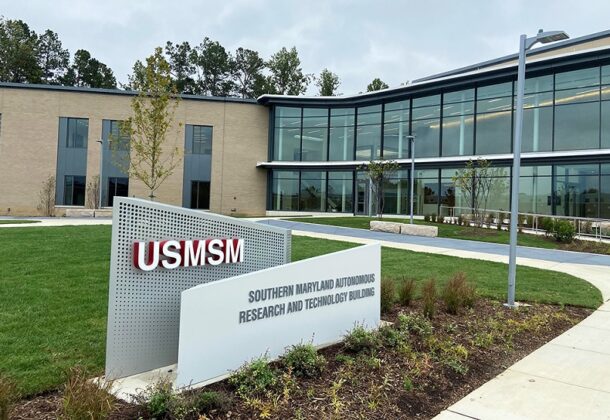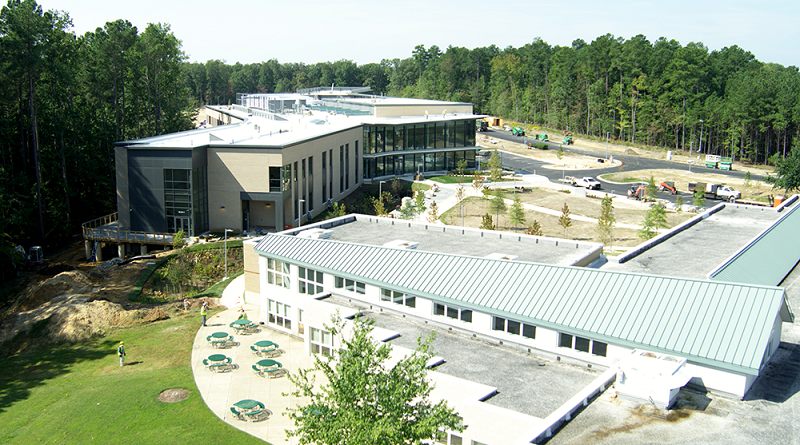USMSM’s SMART Innovation Center Opens

Maryland leaders joined University System of Maryland Chancellor Jay A. Perman earlier this month to celebrate the unveiling of the Academic & Innovation Center for the University System of Maryland at Southern Maryland in California, MD.
The new Southern Maryland Autonomous Research and Technology (SMART) building is an $86 million, 84,000-square-foot academic and research facility that will nearly double the educational footprint of USMSM, create autonomous systems research space, and spur economic activity and job growth.
USMSM, previously known as the Southern Maryland Higher Education Center, formally became the USM’s third regional higher education center on March 1, 2019. Located in St. Mary’s County, the center currently enrolls nearly 300 students in 42 degree and certificate programs offered by five USM institutions: UMCP; Bowie State University; Salisbury University; Towson University; and University of Maryland Global Campus (UMGC). Programs are offered in high-demand areas such as computer science, business administration, criminal justice, education, engineering, nursing, and social work.
Additionally, other educational partners such as Notre Dame of Maryland University and Florida Tech University sponsor degree and certificate programs. USMSM also facilitates the advancement and growth of the Naval Air Station at Patuxent River, as well as defense contractors and the local community, through its extensive conference and training.
“The SMART Building is distinctive for being so important to two missions — on the academic side, allowing us to educate more Southern Maryland students, and on the research side, giving us the kind of state-of-the art space USMSM needs to pioneer unmanned systems technology,” USM Chancellor Perman said.
The academic half of the new SMART Building will nearly double the educational footprint of USMSM. In the new state-of-the-art classrooms, students from across the Southern Maryland region will have enhanced access to in-demand educational programs, giving these students the opportunity to live, work, and study close to home.
The innovation half of the SMART Building features a massive Unmanned Autonomous Systems (UAS) research facility, which will include sea, air, and land capabilities. The facility will make the University System of Maryland at Southern Maryland the USM’s only regional higher education center with a research component.
 The new facility is also expected to be a catalyst for economic activity and job growth in the region.
The new facility is also expected to be a catalyst for economic activity and job growth in the region.
St. Mary’s County is home to several important economic assets — including the St. Mary’s County Regional Airport and NAS Pax River — as well as defense contractors, tech companies, and the business technology incubator, TechPort, which all combine to create a burgeoning “Innovation District” fostering an emerging research-and-development economy in Southern Maryland.
Established 20 years ago, the concept of the USM regional centers is unique nationally. These are not “satellite” campuses of a single university, but rather conveniently and strategically located sites where multiple universities deliver their most in-demand undergraduate, graduate, professional degree, and certificate programs. The regional centers are full-service extensions of the USM that respond to meet the educational needs of students and workforce needs of employers and that are — above all — an affordable alternative to traditional 4-year pathways.
The USM regional centers offer degree programs through partner universities that allow students the opportunity to live, work, and study close to home. As the USM’s third regional center, USMSM will build on previous efforts to ensure that students in areas of the state not located near a public university can access programs offered by the 12 institutions in Maryland’s state higher education system. The USM’s other regional centers are USM Hagerstown and the Universities at Shady Grove.
The SMART Innovation Center will offer the high-bay space of 20 foot ceilings required to test unmanned aircraft. The research conducted at USMSM will take place in tandem with testing programs conducted by the US Navy at Pax River. USMSM estimates that, within eight to 10 years, research revenues from this collaboration could range from $3 million to $5 million per year.






















